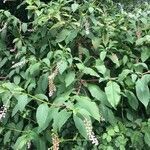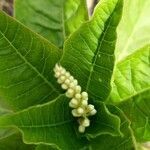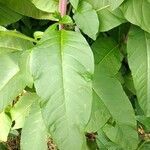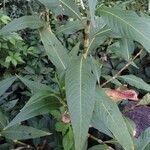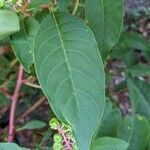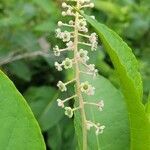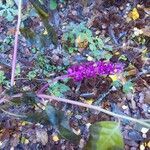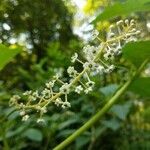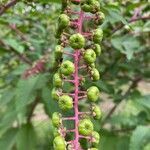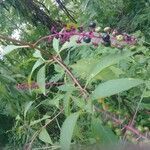Herb or shrub to 1.5 m high, glabrous or sparsely papillate. Leaves petiolate, ovate, elliptic or lanceolate, acute, sometimes apiculate; lamina to 16 cm long and 7 cm wide, the lower leaves sometimes much larger; petiole to 2 cm long. Racemes to 20 cm long. Flowers bisexual; pedicels to 1 cm long, spreading to horizontal, rarely branched. Tepals broadly ovate, 2–4 mm long, white or cream, persistent. Stamens 10, inserted below disc or rarely epitepalous at base of tepals. Carpels 10; styles recurved, c. 0.5 mm long, persistent. Berry depressed-globose, furrowed between seeds, c. 0.8 mm diam., black. Seeds ovoid-compressed, c. 2 mm long, shining black.
Plants to 3(-7) m. Leaves: petiole 1-6 cm; blade lanceolate to ovate, to 35 × 18 cm, base rounded to cordate, apex acuminate. Racemes open, proximalmost pedicels sometimes bearing 2-few flowers, erect to drooping, 6-30 cm; peduncle to 15 cm; pedicel 3-13 mm. Flowers: sepals 5, white or greenish white to pinkish or purplish, ovate to suborbiculate, equal to subequal, 2.5-3.3 mm; stamens (9-)10(-12) in 1 whorl; carpels 6-12, connate at least in proximal 1/2; ovary 6-12-loculed. Berries purple-black, 6-11 mm diam. Seeds black, lenticular, 3 mm, shiny. 2n = 36.
Herbs perennial, 1-2 m tall. Root obconic, thick. Stems erect, sometimes reddish purple, terete. Petiole 1-4 cm; leaf blade elliptic-ovate or ovate-lanceolate, 9-18 × 5-10 cm, base cuneate, apex acute. Racemes terminal or lateral, 5-20 cm. Pedicel 6-8 mm. Flowers ca. 6 mm in diam. Tepals 5, white, slightly red. Stamens, carpels, and styles 10; carpels connate. Infructescence pendent. Berry purple-black when mature, oblate. Seeds reniform-auricular, ca. 3 mm. Fl. Jun-Aug, fr. Aug-Oct. 2n = 18*, 36*.
A herb. It grows to 4 m tall. The root is thick and cone shaped. The stems are erect. The leaf stalk is 1-4 cm long. The leaf blade is oval and 9-18 cm long by 5-10 cm wide. The base is wedge shaped and it tapers to a short tip. The flower racemes can be at the end of branches or on the side. They are 5-20 cm long. The flowers are white and slightly red. The fruiting stalk hangs down. The fruit is a berry which is oblong and purple black when mature. The seeds are kidney shaped and 3 mm across.
Coarse, glabrous, perennial herb to 3 m, branching above; lvs lance-oblong to ovate, 1–3 dm, on petioles 1–5 cm; racemes 1–2 dm, pedunculate, nodding in fr; fls perfect, greenish-white or pinkish, 6 mm wide; stamens and carpels usually each 10; carpels united except for the styles; berry depressed-globose, juicy, dark purple, 1 cm thick; 2n=36. Fields, fence-rows, and damp woods; Me. to Minn., s. to the Gulf of Mexico. July–Sept. (P. decandra)
Perennial, succulent herb, up to 3 m high. Leaves lanceolate-elliptic, mucronate, base acute to obtuse, apex acute; petioles up to 20 mm long. Inflorescences axillary racemes, ± 300 mm long; bracts single, bracteoles coupled, lanceolate. Flowers pink, small, ± 3 mm long; pedicels up to 12 mm long. Sepals 5, ± equal, ovate. Stamens 10 in one whorl. Carpels 10. Flowering time Dec.-Feb. Fruit a berry, ± 10-ribbed.
Succulent herb, up to 1 m high. Inflorescence a raceme. Flowers pedicellate. Carpels completely united. Ripe fruits dark purple-black. Flowers pink.
